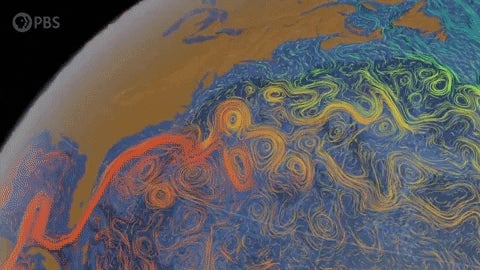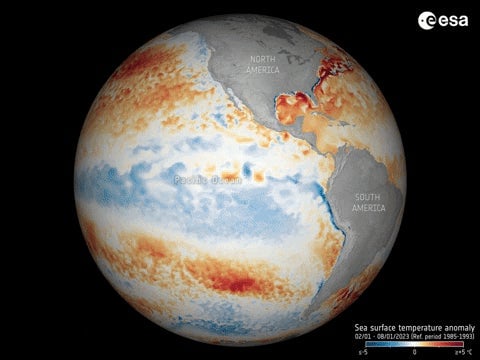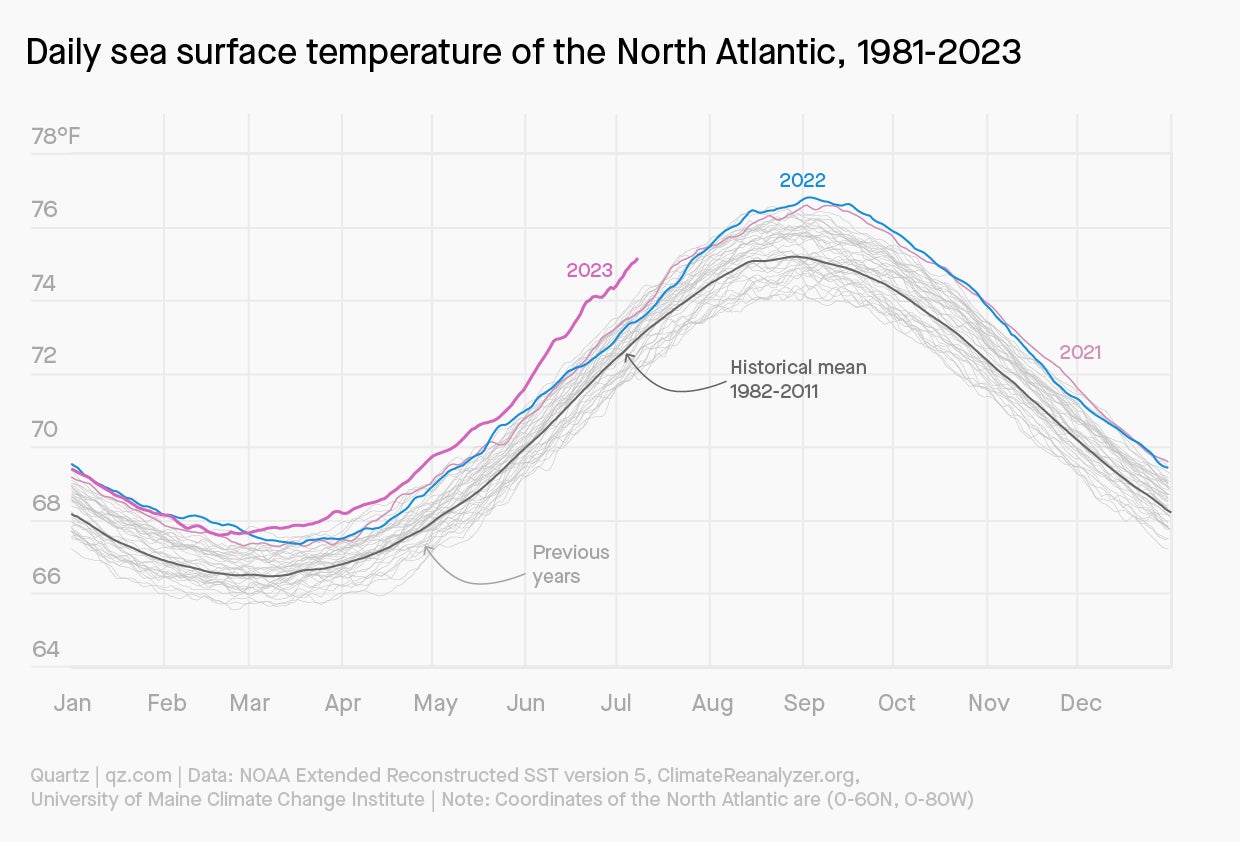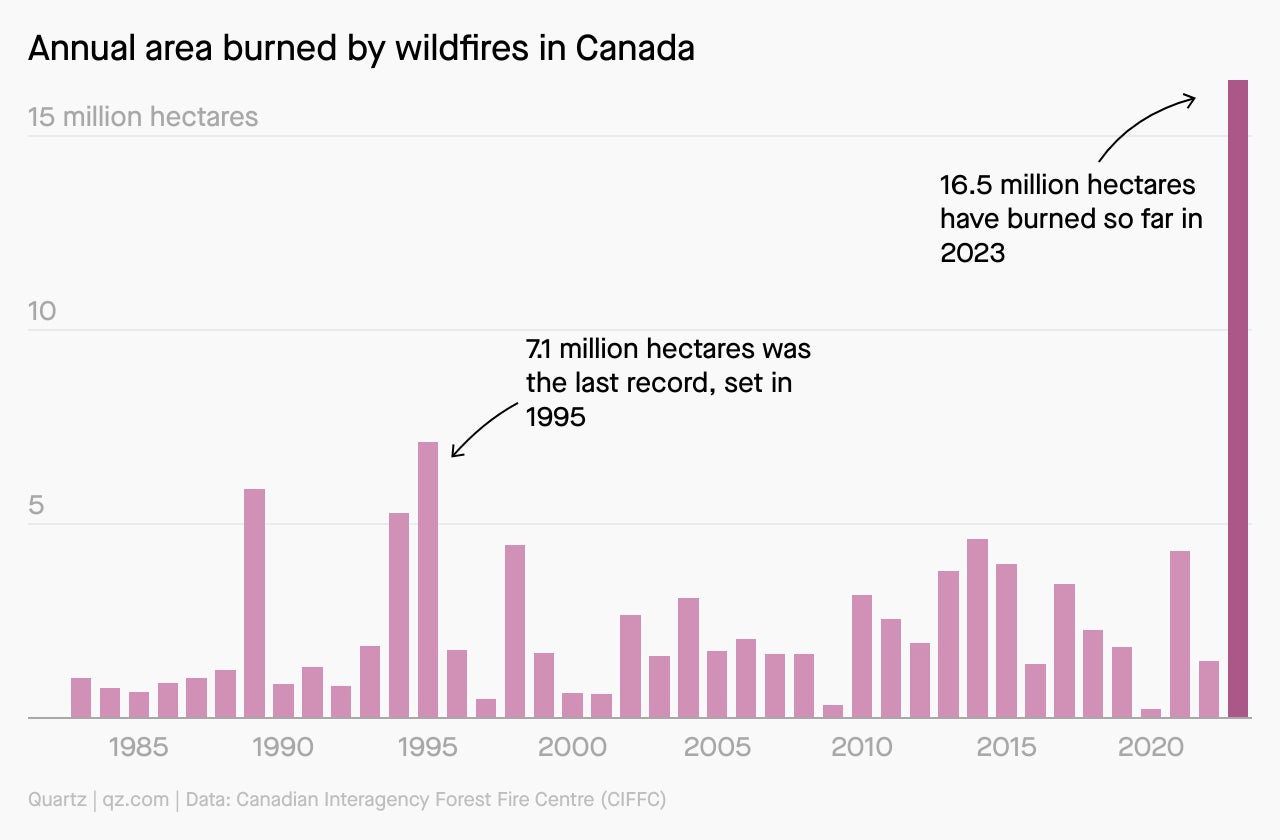El Niño: We’re in hot water
A Pacific punch in climate’s gut

A Pacific punch in climate’s gut
Suggested Reading
There’s a force in nature that’s so powerful it has been cited as at least partially responsible for wiping out ancient Peruvian civilizations, igniting the French Revolution, and teeing up one of the deadliest famines of the 19th century.
Related Content
That force is El Niño, the naturally occurring climate pattern that is characterized by warm surface waters in the central and eastern Pacific Ocean. During an El Niño, trade winds weaken and warm water is pushed east toward the west coasts of the Americas, sending weather patterns into a tizzy. Particularly strong El Niños can touch off extreme winter storms in the US, intense rainfall and flooding in South America, and severe droughts across Indonesia and Australia. Climate change, of course, is turning up the dial on all of this.
Today, the El Niño effect is only getting stronger as rising global temperatures are setting a hotter baseline for the natural warming phenomenon. That compounding effect isn’t good for our ever-more-unlikely goal of keeping global temperatures from rising 1.5°C—actually, El Niño is the very reason why some predict humanity will cross that threshold next year.
Are you ready to dive deeper? Come on in, the water’s—er, barely scalding.
By the digits
9-12 months: How long El Niños usually last
2-7 years: Typical time span between each El Niño, but climate change is shortening this
26: El Niño events since 1900
7: Number of those events that have happened since 2000
34: Provinces in Indonesia, the majority of which experienced a severe drought in the 2014-2016 El Niño season, the last and strongest one since 2000
60 million: People in Southern Africa who were dependent on food aid because of famine during the 2014-2016 El Niño season
Origin story
Back in the 1600s, fishing crews off the coast of South America began noticing something about the ocean. Every few years around Christmas, the water around their boats felt especially warm. They named this phenomenon El Niño de Navidad, which translates to the Christmas child, in reference to the newborn Christ.
That peculiar warming wasn’t anything new. There’s evidence that strong El Niño events occurred as recently as 10,000 years ago during the early Holocene, our current geological epoch, and even millions of years before that. Its correlating extreme weather patterns likely played a role in ending at least two ancient civilizations in Peru. El Niño has never been, and should never be, a force to overlook.
Severe weather related to El Niño isn’t just destructive to daily life—it can upend entire supply chains. The 1877-1878 El Niño, for one, sent the guano industry into a death spiral. At the time, droppings from seabirds in Peru were used as fertilizer around the world. But when the weather pattern killed off a huge number of the birds and rains washed away their guano, the industry went down with them.
Quotable
“We all grumble about the weather, but” (dramatic pause) “—but—but nothing is done about it.”—Mark Twain

Pop quiz
There’s a climate pattern that’s essentially the opposite of El Niño. What’s it called?
A. El Hombre
Find the answer floating in cooler waters at the bottom of this email.
Charted

2023 was the warmest year on record for the North Atlantic Ocean, which felt like a hot tub in some areas. El Niño played a starring role in this heat up.
A little meteorology lesson: Warm conditions in the Pacific influence weather patterns in North America. That creates atmospheric pressure, rain, and storms that pass over the Pacific Northwest and Canada, and eventually make their way down through the northeast US, and end up in the North Atlantic.
A band of warmer air creates conditions for higher temperatures and cloud cover that can develop into heat domes, heat waves, and lightning storms—all things that crank up the boiler on Atlantic waters.
Brief history
1600s: South American fishing crews first notice periods of abnormally warm waters in the Pacific ocean.
1997-1998: El Niño bleaches 16% of the world’s coral.
2002: Villagers from the district of Huachipa outside Lima, Peru, try to slow down an El Niño-induced mudslide by putting stones in the street.
2009: Indonesia suffers a severe drought as El Niño pushes the annual rains to later in the year. The government responds by stockpiling rice.
2018: El Niño causes the worst drought since 1902 in Australia and residents cut back on water use.
2023: Humans record the hottest day on Earth as climate change and the current El Niño effect converge.
Take me down this 🐰 hole!
Nothing quite fanned Canada’s record-breaking wildfire flames in 2023 like the current El Niño. As of September, 16.5 million hectares of land were engulfed, more than double the last record set in 1995.

The area burned this year is staggering, but the number of fires burning isn’t. Most wildfire seasons in Canada see about 6,100 fires, and 2023 hasn’t been any different. Their intensity has changed, though. Drier and hotter temperatures, scaled up by the onset of El Niño, made fires nearly impossible to control.
Fun fact!
El Niño isn’t just about record high temperatures. This year, the western region of the US will likely experience warmer and wetter winter conditions because of El Niño. That won’t be the case in the mid-Atlantic and northeast. There, it’ll likely get chillier earlier, and, much to the delight of snow plowers, business might be about to boom.

Poll
Which weather event would you blame on El Niño?
- Rain on your wedding day
- A summery Halloween
- Too much snow to go home for the holidays
- The outrageous and, frankly, targeted amount of pollen outside of my window
Pretend you’re a meteorologist for a day and give us your forecast.
💬 Let’s talk!
In last week’s poll about The Great British Bake Off, Mel and Sue took the cake as your favorite GBBO presenters (by a long shot). But at least a quarter of you would take Mary Berry over any presenter.
Today’s email was written by Morgan Haefner (have you heard about the wet bulb?) and Clarisa Diaz (a gardener with heat-sensitive plants), and edited by Susan Howson (is now a wet bulb and El Niño proselytizer).
The correct answer to the pop quiz is B., La Niña. During the weather event, the Pacific Ocean is cooler than usual.